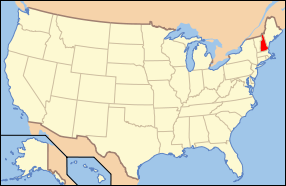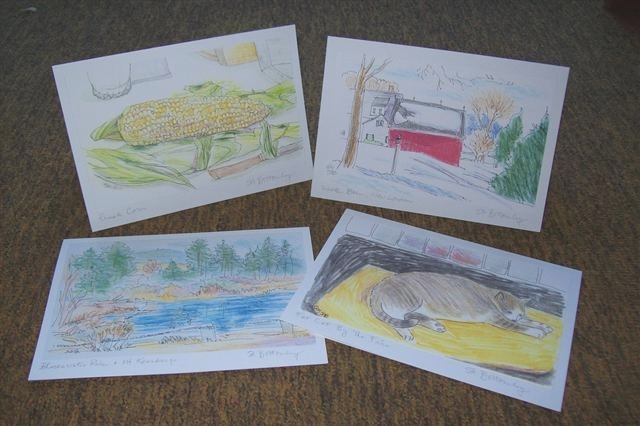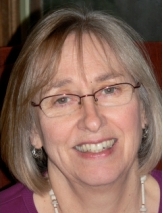While I was outside drawing this beautiful brick library in Kensington NH, my husband was inside getting a deluxe tour from the librarian, who clearly loved the building and the history it represented. The sign above the door says in white letters The Kensington Social Library. The building was a gift of Joseph C. Hilliard in 1895. It has a modern wing out back (nicely concealed so as not to detract from the original architecture), and it is next door to the elementary school. That must be handy for the students. I just love the conflicting architectural devices of this era, e.g. the symmetrical and the asymmetrical windows and columns.
The term ‘social library’ is a holdover from the early 1800’s when libraries in New Hampshire were private book collections. If you joined as a member and paid a fee, you were allowed to borrow. Ironically, libraries are now evolving into more social centers with meeting rooms, and clubs such as knitting. My sister and her husband have recently posted photos of themselves at their library in Wisconsin...one while enjoying a Death by Chocolate cooking competition and another at a costume party.
My drawings and watercolor paintings always indicate the weather and the season as well as the architecture. The trees in spring are yellow-green and pink.
When I am driving around in my project of drawing every town in New Hampshire, two thoughts are usually floating around in my head: “Oh, I have never seen that before” and “Oh, that building really looks like the one in such and such a place”. If the towns are close together, I sometimes feel I am following around a local architect/builder. And I know that pattern books and mail order trimmings were readily available, so that could explain many of the similarities.
This is Bedford Center, NH. The town hall is in the center, which includes the Narragansett Grange No. 16. The yellow building is a private home, and just to the left of that are small views of the end of the town library. And the white building on the far left is a home.
Granges were established a in the mid 1800’s as a social movement. This was an era when half the population left to move to better farmland in the midwest states of the US. Those who stayed behind suffered from the lack of man power to keep the land in agriculture. Most fields quickly reverted to woodland, and New Hampshire slid into a severe economic decline. For decades.
The yellow shrub is called forsythia, which cheerfully blooms early. It blooms before its leaves pop out so the color effect is dramatic. Since this has been a cool spring, they are still in bloom a month later. The odd brown shape to the far right is a vine on an arbor.
If you should go to Bedford Center, you will not see this exact view. I drew it as I was walking up the road, adding new details and sightlines as I went around a corner. That is the fun of drawing on location.
These are the main cross roads in Gilmanton, NH. The tallest building in the center is the home of the town offices. On the left stands the Gilmanton Community Church, and on the right is a small scale public library. I didn’t check to see how many copies of the novel Peyton Place (Grace Metalious, 1956) may be inside. It was always said that she based the plot and characters in her scandalous novel on this town, where she was living when she penned it.
The town office, grand in scale but built of wooden clapboards, has an unusual window. It is circular and resembles a globe in an atlas. Tricky to draw.
Notice the granite pillars along the roadway. There were too many to count, but they seemed such a part of the place that I had to fit in three. They were once part of a fence. I wouldn’t want to meet one with a car fender. New Hampshire is the Granite State.
My historical advisor tells me that the ‘traditional’ white New England buildings date only to the 1930’s. A conference was held and sponsored by Yankee Magazine. The attendees discussed how to get more tourists to come to New England, stay longer, and spend more money. It was agreed that painting all the buildings white would have a unifying effect and successfully convey quaintness. The paint companies were most happy to assist and encourage this thought. (Up to this point, the buildings were left unpainted or painted with whatever was the least expensive color available.) No harmony at all in other words. Litchfield, Connecticut was selected as a trial town. White paint was slapped on all the buildings in the town center. Then the owners were required to attach black or dark green shutters. Voilà, instant charm. (The plague of shutters with no function continues to this day. Don’t get me started on shutters that don’t shut.) It worked. Tourism picked up, and paint brushes and buckets emerged all over the six New England states: Maine, New Hampshire, Vermont, Massachusetts, Connecticut and Rhode Island.
Fremont is a small town in the southeast part of New Hampshire. I decided to draw their town pound viewed from the inside. In earlier days, wandering livestock would be corralled into this enclosed space until the owner could come claim them. It is made of small granite boulders and upright granite posts. It is kept as a relic, and somebody must be restacking the stones from time to time because these kinds of walls do tumble down. It is not easy to draw rocks. I try to draw the idea of rocks, if you see what I mean. In behind is the Poplin Meeting House, 1800, in white clapboard, and a graveyard across the road.
My paternal grandfather and his parents and brothers came south from Quebec, Canada to work in the granite quarries of Concord, NH. I think they may have been stonemasons in Quebec as well.
Fremont has an historical marker about the town’s Mast Tree Riot in 1734. This was a little altercation between local tree owners and the English Crown. It seems the Crown reserved the tallest and straightest pine trees as masts for the king’s ships. And some folks objected.
And here we have another stone town pound in the tiny town of Windsor, just west of Hillsborough. It has a population of about 200 in about 8 square miles It was known as Campbell’s Gore originally. A gore is a wedge shaped piece of land, sort of a leftover. The sign in the center notes that the fee for claiming an impounded animal was 50 cents per day—quite a large sum by the standards of the time. Little volunteer evergreens are sprouting in the center. I like how I could see through the woods to a lake and a mountain.
I decided to gather a few of my drawings of schools, in honor of the winding down of the school year. Schools in North American close for the summer, in early to mid June. The summer camp industry has grown to fill in the gap of time in the summer. I am a volunteer at our local elementary school, where I talk about art history once a month.
To make this drawing, I peered in through very dusty windows. It is the Bow Center Schoolhouse, 1894, in Bow NH, and is no longer in use. Of note, the black slate writing board. The lettering above this chalkboard is called the Palmer Penmanship script. I think it is still taught in North America. It is a distinctive style that does not resemble that of England, Europe, or anywhere. Most people evolve a simpler form as soon as they leave elementary school, age 10. Most of my letters look like printing, although some are still loopy.
To continue with the school theme, here is the former high school in Ashland, NH. It sits high on a hill and is a Victorian era gem. My father had his first teaching job here, in the late 1940’s and early 1950’s. He taught all the mathematics and science classes for ages 14–17. As a first teaching job, it sounds very challenging. I was about 4 or 5 years old.
My memories include my pet hamster, and the five and dime store down the street. It was not a Woolworth chain store, but similar in concept. The counters and shelves were so low I could see all the assortments of lipsticks, frilly handkerchiefs, and fake pearl clip-on earrings.
The next year we moved to Massachusetts, where the starting salary for teachers was greater. We lived in Westford, moving into three different houses, until I was fourteen.
Brookline, NH borders the state of Massachusetts in the south. I seem to be drawn like a moth to yellow buildings. This is the large square building of the town offices. It is the former home of the Daniels Academy, founded in 1905 for girls and boys. It looks dignified and solid, and well worth repurposing.
New Ipswich is a small town along the Massachusetts border. I bought a coffee and a cookie at a small store, for a break. The coffee shop was next door to this elementary school, the New Ipswich Center School. I really liked that green awning that shelters the students from the weather.
My father-in-law was not a very hard working student in high school. He was sent off to the New Hampton School in New Hampton, NH for a year after he graduated, for the purpose of bringing up his grades so that he would be accepted to a university. This was accomplished through enforced study halls. And the lack of female students in his classes helped too, I’m very sure. My father-in-law had a facetiously pompous way of speech. Right now I can hear his voice, from the hereafter, urging me to use the word ‘pulchritude’. Which is a very awkward sounding word meaning beauty of females.
Anyway, this is Lane Hall on the campus of the New Hampton School, built in 1919. The planter has a date of 1890 on it.
This building has what I call cowboy style architecture. It is the Deadwood Junction in Greenwood, British Columbia, Canada. It has wonderful coffee, pastries, and rooms of arts and crafts. And very friendly owners and staff.
I read that Greenwood, Canada’s smallest city (a form of government distinct from that of a town), with about 700 people as it says on the sign, just won the top award at Berkeley Springs, West Virginia—the international competition for the best tasting municipal tap water in the world. This is one reason why their coffee is so good, no doubt.
We happen to pass through Greenwood when we drive from Spokane, Washington to Kelowna, British Columbia, Canada to visit our family, including our three grandchildren. We got a recommendation from some people walking down the street in Grand Forks, a mere 40 miles or so east. Even though it is spring time, the climate is very dry here as indicated by the yellow hills in the background.
Sometimes we do a bit of exploring on our own while we are visiting family in British Columbia. One sunny day we decided to explore the Father Pandosy Mission. In 1859 a group of Oblate priests made a home in the Kelowna valley, the first group of white settlers. My quick online research tells me that Father Pandosy was born in Marseilles. France. And that the word ‘oblate’ means sacrifice. I believe the fathers started farming and planting orchards.
So I decided to draw this barn, as I had never drawn a saddlenotch log construction before. And I drew, or attempted to draw, the complex farming mower or reaper on the right. It was just one of many highly mechanical farm implements on display there. In the background is Black Mountain. I moved it slightly to the right. (Yes, I move mountains.)
And now there is an upscale shopping district in Kelowna called Pandosy. The building on the left is not old at all. Just a funky, contemporary nod to the old, which houses the Marmalade Cat Café. I can’t resist yellow buildings. And yellow, blue and rust colored buildings really hold my attention. I can’t explain this and that doesn’t bother me. There is still snow on the high hills.
We sat in a lovely coffee shop while I drew this. And knowing that the new building will block the view.
And one more last one, including our grandson playing in a toy train. It is a stationary train. Only imagination makes it move. We go to the park often when we visit. It’s a grandparent thing.
The climate here in eastern British Columbia, the Okanagan, is semi-arid. It is the northern end of the Sonoma desert which starts in Mexico. So the ground is dry with desert type plants and animals. But it has lots of lakes and beaches too. We get ourselves there as often as we can. Which is often.



















No comments:
Post a Comment